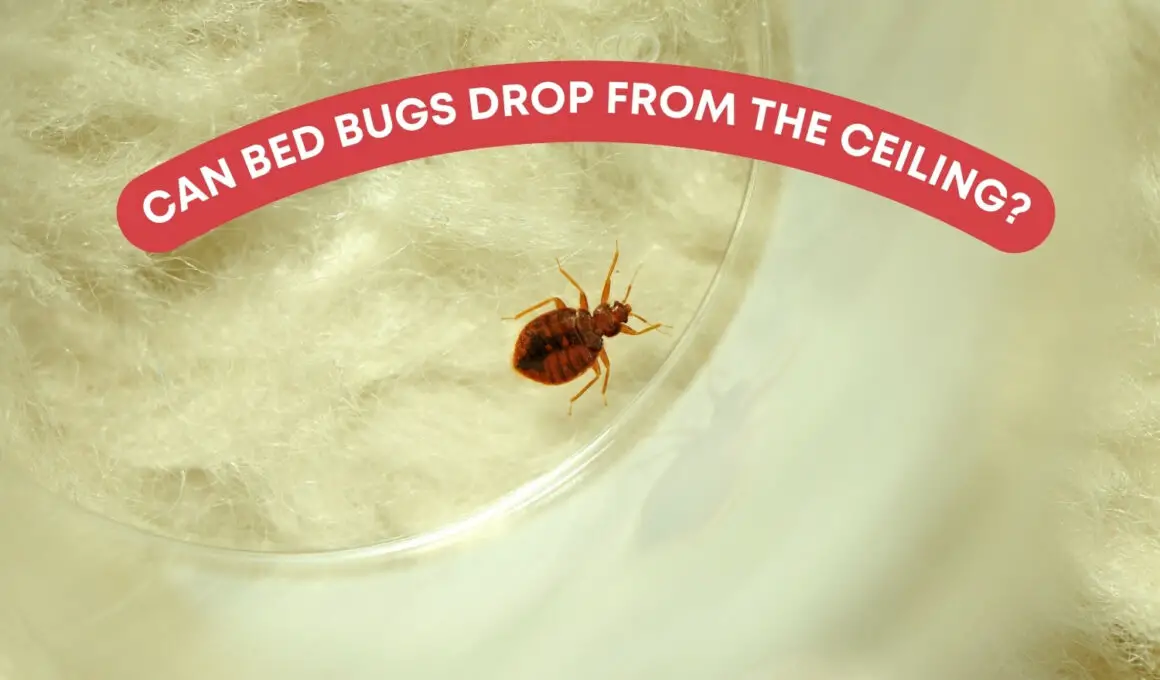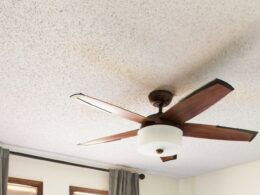Table of Contents Show
As an experienced homeowner and contractor, I’ve encountered a wide range of household challenges, from simple fixes to complex renovations. One issue that often puzzles and concerns many is the presence of bed bugs, particularly the question: Can bed bugs drop from the ceiling?
Bed bugs, notorious for their stealthy existence and uncomfortable bites, are a common concern in many homes. Contrary to popular belief, these tiny pests aren’t limited to just mattresses and bed frames.
Understanding their behavior and habitats is crucial in effectively managing and preventing infestations. In this article, we’ll explore the reality of bed bugs in our homes, focusing specifically on whether they can travel from ceilings to other areas.
Can Bed Bugs Drop From The Ceiling?
Yes, bed bugs can potentially drop from the ceiling, although it’s not their typical behavior. Bed bugs are known for their ability to climb various surfaces, including walls and ceilings. In situations where they infest ceiling fixtures or upper parts of a room, they can drop down. However, it’s more common for bed bugs to travel to beds, furniture, and other areas by crawling. Effective bed bug control involves identifying and treating their common hiding places, including beds, furniture, and even ceilings in severe infestations.

How Bed Bugs Infest Homes
Understanding how bed bugs enter and spread in homes is crucial for effective prevention and control. Despite their small size, bed bugs are adept at infiltrating residential spaces, often hitchhiking unnoticed on various items.
Routes of Bed Bug Entry
Travel and Luggage
One of the most common ways bed bugs enter homes is through travel. These pests easily hitch rides in luggage, clothing, and personal belongings from hotels, hostels, or other accommodations where they might be present. When travelers return home, the bed bugs disembark from these items, finding new habitats in the household.
Used Furniture and Second-Hand Items
Purchasing or acquiring used furniture, especially mattresses, bed frames, and sofas, is a significant risk factor. Bed bugs can reside within these items, and once brought into your home, they can quickly infest the area. It’s not just furniture; second-hand clothing, books, and other items can also be carriers.
Adjacent Units and Shared Spaces
In apartment buildings, condos, or townhouses, bed bugs can travel between units through shared walls, ducts, and pipes. This is particularly problematic in densely populated residential areas where infestations can spread rapidly from one unit to another.
Visitors and Guests
Guests staying in your home may unintentionally bring bed bugs along with their belongings, particularly if they’ve stayed in infested places before visiting.
Public Transport and Shared Facilities
Bed bugs can also be transferred from public spaces like buses, trains, theaters, and laundromats. They cling onto clothing or personal items and are then inadvertently brought into homes.
The Spread of Bed Bugs in Residential Areas
Once inside a home, bed bugs can spread in several ways:
1. Room-to-Room Migration
Bed bugs can easily crawl between rooms in search of food (human blood) or new hiding places, leading to widespread infestation throughout the home.
2. Breeding and Rapid Population Growth
Female bed bugs lay hundreds of eggs in their lifetime, leading to a rapid increase in population if not controlled.
3. Lack of Awareness
Often, people are unaware of bed bugs due to their small size and nocturnal nature, allowing them to spread unchecked.
4. Resilience and Hiding Ability
Bed bugs can survive for months without feeding and can hide in extremely small cracks and crevices, making them difficult to detect and eradicate.
Prevention and Control
Preventing and controlling bed bug infestations requires a combination of vigilance, knowledge, and proactive measures. Implementing effective strategies can significantly reduce the risk of bed bug infestations and control their spread if they do occur.

Strategies for Preventing Bed Bug Infestations
Regular Inspections
Regularly inspect your home, especially bedrooms and living areas, for signs of bed bugs. Look for small, reddish-brown bugs, tiny white eggs, or black spots (bed bug excrement) on bedding, mattresses, and furniture.
Travel Wisely
When traveling, inspect hotel rooms for bed bugs, particularly the bed area. Keep luggage on luggage racks, away from the bed and walls, and consider using luggage protectors. Upon returning home, wash and dry all clothing on high heat and vacuum your luggage.
Careful with Second-Hand Items
Be cautious when acquiring used furniture or clothing. Thoroughly inspect and clean these items before bringing them into your home. Consider avoiding used mattresses and upholstered furniture, as they are common hiding places for bed bugs.
Use Protective Covers
Encase mattresses and box springs with bed bug-proof covers. These covers can prevent bed bugs from entering or escaping from these common hiding spots.
Reduce Clutter
Clutter provides hiding places for bed bugs, making it harder to detect and eliminate them. Keep your home organized and clean, reducing the number of spots bed bugs can hide.
Best Practices for Bed Bug Control
1. Immediate Action
At the first sign of a bed bug infestation, act quickly. The sooner you address the problem, the easier it will be to control.
2. Heat Treatment
Bed bugs are highly susceptible to heat. Washing bedding and clothing in hot water and drying them on the highest dryer setting can kill bed bugs. Similarly, steam cleaning can be effective for furniture and mattresses.
3. Vacuum Regularly
Vacuuming can remove bed bugs and their eggs from carpets, floors, and furniture. Be sure to dispose of the vacuum bag in a sealed plastic bag immediately after use.
4. Chemical Treatments
There are various pesticides specifically designed for bed bug control. It’s crucial to use these chemicals safely and according to the manufacturer’s instructions. In many cases, professional pest control services are recommended for effective chemical treatment.













